|
KettleBag? |
|
Kettlebells have really been
increasing in popularity recently and I frequently have
people ask me questions about what I think about them.
Personally, I think kettlebell training is great and there
are a lot of exercises that you can perform with them.
There have always been heavy kettlebells that are used by
athletes for strength and conditioning, and now there are
some lighter (and prettier) kettlebells that are starting to
be used for toning and trimming in the standard group
fitness classes.
The Kettlebell is a cast
iron weight, which resembles a basketball with a handle. A Russian
exercise device used for more than 100 years, Kettlebells have long been
a favorite in that country for those seeking a special edge in strength
and endurance.

Kettlebell training is great if
you belong to a club that provides them, however they are
not that cheap if you were to buy a few of them for your
home. Most serious lifters that start kettlebell
training will first pick up a standard 35 lb kettlebell.
The significance of this weight is in the origins of
kettlebell training in which the russian lifters referred to
it as 1 "pood" (16.38 Kg or 36.11 lbs). Although you
can pick up a new 35 lb kettlebell in the store for roughly
$55 and be plenty happy with it, the situation still exists
that you would have to run out and pick up another one (or
two, or three) once you grow out of it. Although I
have posted a few plans for homemade, adjustable kettlebells
in previous newsletters (1
hand,
2 hand), there is an even
easier way of getting the same effective training stimulus
for serious strength training!
So here's what you need: a
50 lb bag of sand ($3.50), a heavy duty contractor trash bag
or two, and a nice strong canvas duffle bag (I picked up a
cheap lot of army surplus canvas tent bags that work great).
Simple enough: trash bag in the canvas bag, sand into the
trash bag(s), tie it up good (duct tape optional), and close
the canvas bag up (shoelace or closure). So instead of
buying a 35 lb kettlebell that I will grow out of, I made
this 35 lb sandbag below that really adds a nice grip
workout to my kettlebell exercises.
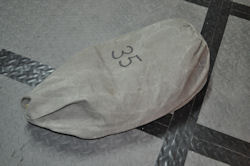
I love sandbags. I
probably have almost a dozen of them in my gym currently
that I use for a variety of different exercises. It
may be old school, primitive, exercise equipment... but you
cannot argue with the low investment and high productivity
that these simple tools produce!
Here are a few pictures of some
standard kettlebell exercises being performed with my 35lb
bag.
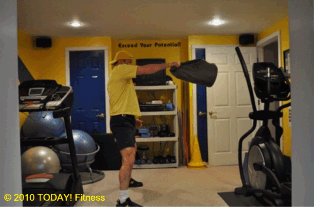
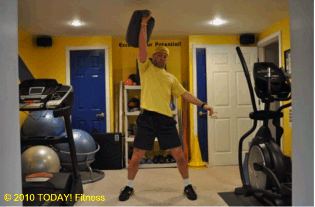


So in
summary, while I do believe that kettlebells are a very
effective training tool, I also believe that there are
alternative tools that can accomplish many of the same
exercises. If you want to invest in a kettlebell or
two for your home gym, then have at it. If not, then
the kettlebag may be an option for you to mix things up!
|
|
Complex is
Simple |
|
If you're tired of enduring cardio session
after cardio session to get fit, you might want to give the
newest training method a try: complexes. When your main goal
is to lose body fat, cardio is one
of the best options to achieve results. High-intensity interval training
has become the preferred method over steady-state cardio as
it increases the amount of calories you
burn after the session is done, allowing you to burn a
greater amount of fat for the remainder of the day.
Now, however, high intensity interval
training is starting to take a backseat to
complex training. Don't think that complex training is just circuit training
in disguise though -- with circuit training you are
basically performing regular weight lifting exercises with
no rest. But, with complex training you are performing whole
body movements that flow together in a fashion that allows
you to keep your heart rate up while also improving
neuromuscular coordination.
Complex training is a type of weight lifting that is meant
to replace your traditional cardio sessions. Because the
body often shows adaptation to repetitive endurance
activities, complexes allow you to overcome this barrier so
you are consistently getting results from your workout.
Additionally, because complexes are done using strength
training exercises, there will be a better transfer to your
lifting workouts as well.
Due to the manner in which complex training is performed you
will be primarily focusing on the cardiovascular side of
your conditioning, rather than the pure strength side. This
means that while they are definitely a good addition to your
weight training,
complexes are by no means a replacement.
Training with complexes
Complex training involves a number of exercises performed in
succession. During this time you will need to keep the
weight exactly the same so that you can move fluidly from
one exercise to the next. Because of this lack of a break
period, you will increase your metabolism sufficiently so
that the routine is more comparable with a high intensity
interval training cardio session.
After choosing the exercises that you will perform, you will
want to complete all of your specified reps for one exercise
and then move to the next immediately afterward. It is not
an alternating type of protocol where you would perform a
squat movement, then an overhead press movement, followed by
another squat movement
then an overhead press and so on. Rather, you would do all
of your squats, then
move directly into your overhead press reps.
This type of workout is incredibly demanding on the body in
terms of metabolic processes and recovery, so you will
definitely need to keep that in mind. The weight you are
using will need to be reduced drastically from the amount
you would normally lift, particularly as you are reaching
the end of the complex series when both your muscular and
nervous system are likely to be extremely fatigued. Don't
try and be macho for these exercises -- less really is more
when it comes to complexes.
Here are a few examples of complex exercises
that you could perform.
·
Deadlift
·
Bent over row
·
Power clean
·
Front squat
·
Shoulder press
·
Back squat
·
Back hyperextension
·
Upright row
·
Reverse lunge
·
Military press
·
Jump squat
After you have completed each set of movements, go to the
next without a pause until you are at the end of the list.
Then rest for a short period of time (60 to 90 seconds)
before completing the circuit again in the same fashion. Try
and work your way up to completing four or five total
circuits.
As you start making progress on this type of training, you
can work on completing either more reps per movement, a
greater number of circuits or decreasing the total time
between exercises. Do keep in mind that your goal is to
not make these endurance
sessions. They should be kept relatively short, so if you
progress far enough that you are at about eight reps per
exercise and completing six circuits, your best move then is
to increase the weight slightly.
Final points to keep in mind
Keep in mind are that you should always be using familiar
movements that you are comfortable with. You want the entire
sequences of exercises to flow really smoothly and if you
are struggling with simple execution factors, this will
definitely be an obstacle.
Also, the weight that
you can comfortably do on the weakest exercise should be the
weight that you choose to lift for all the exercises
remaining in the sequence. Because of this factor, you do
not want to choose isolation exercises to use in your
complex training -- such as bicep curls or tricep kickbacks
-- because these smaller muscles will not be able to handle
the weight you are using on the more complex lifts in the
sequence. You could reduce the weight in order to
accommodate these isolation exercises, but then similarly
the complex ones will not be challenging enough. Your best
bet is to simply stick with more compound lifting movements.
Lastly, try and use exercises that will flow naturally
without you having to move into awkward positions to
readjust yourself or having to change hand placement a whole
lot on the bar. The less downtime you have during these
complexes the better the benefits and your conditioning
level will be.
the simplicity of complexes
So, next time you're on the treadmill, bike or elliptical
trainer and are feeling less than enthused, consider
replacing that type of training with complexes. They will
take up less of your time and you will reap much greater
rewards provided they are performed correctly. Just remember
that these are very taxing on the body so you will need to
be sure you coordinate them well with the rest of your workouts along
with making sure you get enough rest between sessions. Doing
complexes twice per week to start is a good recommendation
and then you can adjust as you see fit over time.
Here's a link to a sandbag interval complex that I've been
doing. This 25-30 minute workout gets my heart rate up
around 160 bpm towards the end and I definitely feel like
I've kicked my own butt enough by the time I'm done!
Sandbag Interval Complex
|
|

|
|
|
Partner Bodyweight Exercise of the Month! |
|
Partner Dip
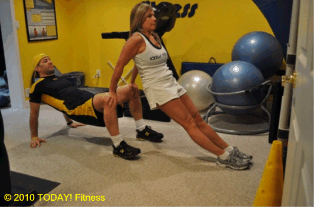
Summary:
Dips have long been a favorite exercise for toning and
building strong and shapely triceps. This partner dip
may look unusual, but it provides an excellent option when
there is no access to appropriate equipment (or a chair).
Remember that the next time you need to get a quick pump at
the beach ; )
Target: arms and core
(triceps and abdominals)
Count:
2 count
Description: Starting
position begins with one person getting into a crab position,
raising up, and maintaining an isometric hold... keeping their
knees completely still. The other person places their
hands on their partner's knees and extends their legs out
straight. The dips are performed by lowering down for
full range of motion and extending back up.
|
|
Plantar Fasciitis |
|
Plantar
fasciitis is a common, painful foot condition. Patients, and
sometimes doctors often confuse the terms plantar fasciitis
and
heel spurs. Plantar fasciitis refers to the
syndrome of inflammation of the band of tissue that runs from
the heel along the arch of the foot; a heel spur is a hook of bone that can form on the
heel bone (calcaneus). 70% of patients with plantar
fasciitis have been noted to have a heel spur that can be seen
on X-Ray.
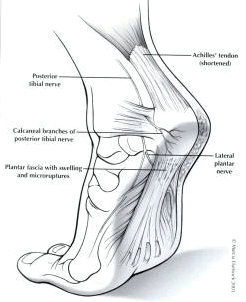
Who gets plantar
fasciitis?
Plantar fasciitis is most often seen in middle-aged men and
women, but can be found in all age groups. Plantar fasciitis
is diagnosed with the classic symptoms of pain well localized
over the heel area of the bottom of the foot.
Plantar fasciitis is
sometimes, associated with a rapid gain of
weight. Plantar fasciitis is also sometimes seen in
recreational athletes, especially runners. In these athletes,
it is thought that the repetitive nature of the sports causes
the damage to the fibrous tissue that forms the arch of the
foot.
Could something other
than plantar fasciitis cause this pain?
Plantar fasciitis can be confused with a condition called
tarsal tunnel syndrome. In tarsal tunnel syndrome, an
important nerve in the foot, the tibial nerve, is trapped and
pinched as it passes through the tarsal tunnel, a condition
analogous to
carpal tunnel syndrome in the wrist. This may cause
symptoms similar to the pain of a plantar fasciitis. There are also other
less common problems such as nerve entrapments, stress
fractures, and fat pad necrosis, all of which can cause foot
pain. Finally, several rheumatologic conditions can cause heel
pain. A doctor may consider testing for any of these
other problems while diagnosing the issue.
Causes of Plantar Fasciitis
The most common cause of
plantar fasciitis is very tight calf muscles which leads to
prolonged and / or high velocity pronation of the foot. This
in turn produces repetitive over-stretching of the plantar
fascia leading to possible inflammation and thickening of the
tendon.
This strong and tight tissue contributes to
maintaining the arch of the foot. It is also one of the major
transmitters of weight across the foot as you walk or run.
Therefore, the stress placed on the this tissue is tremendous.
As the fascia
thickens it looses flexibility and strength.
Some practitioners think
overpronation can always be determined by the dropping and
rolling in of the arch. This is not always the case. Sometimes
it can only be seen with foot scans, especially if the patient
has a high arched foot.
Other causes include high arch
or low arch feet and other biomechanical
abnormalities including
oversupination which should be assessed by a podiatrist /
physiotherapist / biomechanist.
Excessive walking in footwear
which does not provide adequate arch support has been
attributed to plantar fasciitis. In addition, overweight
individuals are more at risk of developing the condition due
to the excess weight impacting on the foot.
Symptoms of plantar
fasciitis are typically worsened early in the morning after
sleep. At that time, the arch tissue is tight and simple
movements stretch the contracted tissue. As you begin to
loosen the foot, the pain usually subsides, but often returns
with prolonged standing or walking.
Treatment
Treatment
of plantar fasciitis is with short-term rest and controlling
the inflammation. Here are the steps patients should take in
order to cure their plantar fasciitis:
-
Rest -
Avoiding the precipitating activity; for example, take a few
day off jogging or prolonged standing/walking. Just resting
usually helps to eliminate the most severe pain, and will
allow the inflammation to begin to cool down.
-
Apply Ice Packs
- Icing will help to diminish some of the symptoms and control
the heel pain. Icing is especially helpful after an acute
exacerbation of symptoms.
-
Exercises and Stretches
- Exercises and stretches are designed to relax the tissues that
surround the heel bone. Some simple exercises, performed in
the morning and evening, often help patients feel better
quickly.
-
Anti-Inflammatory Medications
- Anti-inflammatory medications help to both control pain and
decrease inflammation. Over-the-counter medications are
usually sufficient, but prescription options are also
available.
-
Shoe Inserts
- Shoe inserts are often the key to successful treatment of
plantar fasciitis. The shoe inserts often permit patients to
continue their routine activities without pain.
-
Athletic Taping - A good
plantar fasciitis taping technique can help the foot get
the rest it needs by supporting the plantar fascia. Tape is
applied in strips across the plantar fascia taking the
stress off the foot which healing to take place.
-
Night Splints
-
Night splints are worn to keep the heel stretched out when you
sleep. By doing so, the arch of the foot does not become
contracted at night, and is hopefully not as painful in the
morning.
These
modalities alone will cure the plantar fasciitis pain in most
patients. Be forewarned that the symptoms will not resolve
quickly. Most patients find relief within about three months,
and over 90% within one year.
If the pain does not
resolve, an
injection of cortisone can decrease the inflammation of
plantar fasciitis. However, many physicians do not like to
inject cortisone because there are potentially serious
problems with cortisone injections in the heel area. The two
problems that cause concern are fat pad atrophy and plantar
fascial rupture. Both of these problems occur in a very small
percentage of patients, but they can cause a worsening of heel
pain symptoms.
A new treatment for
chronic plantar fasciitis is being investigated. This
treatment, called extracorporeal shock wave therapy, or ESWT,
uses energy pulses to induce microtrauma to the tissue of the
plantar fascia. This microtrauma is thought to induce a tissue
repair process by the body. ESWT is recommended in patients
who have failed the previously mentioned treatments, and are
considering surgical options. For more information on shock
wave therapy treatment:
After
successful treatment, how can I prevent plantar fasciitis from
coming back?
To prevent the recurrence of plantar fasciitis after
treatment, proper fitting footwear is essential. Many people
use shoe inserts to relieve pressure over the tender area.
Custom orthotics can also be made if there appears to be a
problem with the mechanical structure of the foot. It is also
important to
continue the stretching and exercises
to maintain the flexibility of the foot and
prevent the plantar fasciitis pain from returning.
What if the symptoms
do not resolve?
In a small number of cases (usually less than 5%), patients
may not experience relief after trying the recommendations
listed above. It is important that conservative treatments
(such as those listed above) be performed for AT LEAST a year
before
considering surgery. Time is very important in curing the
pain of plantar fasciitis, and insufficient treatment before
surgery may subject you to potential complications of the
procedure. If these treatments fail, your doctor
may consider an operation to
loosen the plantar fascia, called a plantar fascia release.
Because the diagnosis
of plantar fasciitis can be confused with tarsal tunnel
syndrome (as described earlier), most surgeons advocate
performing a tarsal tunnel release (or at least a partial
tarsal tunnel release) along with the plantar fascia release.
This surgery is about 80% successful in relieving pain in the
small group of patients who do not improve with conservative
treatments.
|
|
It's Go Time!
|
|
Ah spring... now that's what I'm
talking about. Although I workout all year round, I
can't say that I am a particular fan of indoor cardio.
I'd much rather go for a ride or run outside. The change
in scenery, the feel of the wind, and overall energy that the
outdoors brings does quite bit for my motivation.
In addition to motivation, the outdoors brings so many more
options to choose from when planning your workouts.
If spring motivates you too, then
take this opportunity to commit to some type of fitness
challenge. There are plenty of walks, runs, and rides
for charity that you can register for now. Get a friend
to register with you while you're at it. Once you make a
serious commitment by registering, it will provide you with
continuous motivation between now and game day.
For
prior issues of this eNewsletter, to subscribe, or
unsubscribe, please visit the following
link -->
todayfitness.net/news.
Exceed Your
Potential!
Pete
Mazzeo, CPT
pmazzeo@todayfitness.net
" You
do not pay the price of success, you enjoy
the price of success"
youtube of the month -->
Dan Gable Inspiration
Although Dan Gable was a legendary wrestler and coach, you
don't have to be a wrestler to appreciate his
determination and attitude!
|
|